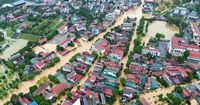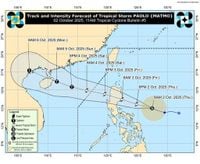As Tropical Storm Matmo barrels across the Pacific, communities in the Philippines and southern China are bracing for another round of severe weather, just days after the region was battered by Super Typhoon Ragasa and Typhoon Bualoi. On Thursday, October 2, 2025, weather agencies across Asia issued urgent warnings as Matmo intensified over the Philippine Sea, poised to strike the country’s most populous island and threaten millions along its projected path.
According to the Philippine Atmospheric, Geophysical and Astronomical Services Administration (Pagasa), the storm—known locally as Paolo and internationally as Matmo—gained strength Thursday morning. Pagasa’s 11 a.m. update reported that Paolo was located 575 kilometers east of Infanta, Quezon, packing maximum sustained winds of 75 kilometers per hour (kph) near the center and gusts reaching up to 90 kph. The storm was moving west-northwest at 20 kph, a pace that put it on course to make landfall over Isabela or northern Aurora provinces by Friday morning, October 3.
With the storm’s approach, Pagasa raised Tropical Cyclone Wind Signal (TCWS) No. 2 over the southeastern portion of Isabela, the northern part of Quirino, and northern Aurora. This signal, which carries a 24-hour lead time before the storm’s effects are felt, warns residents of minor to moderate threats to life and property. A broader swath of Luzon, including provinces such as Cagayan, Nueva Vizcaya, Benguet, Ilocos Norte, and others, was placed under Signal No. 1, indicating a 36-hour lead time and a minimal to minor threat from the storm’s winds and rain.
The Philippine weather agency also flagged a moderate risk of life-threatening storm surge in low-lying coastal areas within the next 36 hours. Sea travel was deemed risky for all types of vessels in the affected regions. "We urge all residents, especially those in vulnerable communities, to heed evacuation orders and stay tuned to official bulletins," a Pagasa spokesperson advised, emphasizing the unpredictability of tropical cyclone behavior.
Matmo’s immediate impact is compounded by the Philippines’ recent struggles. The central region is still reeling from a deadly earthquake that claimed dozens of lives, complicating disaster response efforts as communities brace for yet another natural hazard. The threat of flooding and landslides looms large, particularly in areas already weakened by previous storms and seismic activity.
Hong Kong’s observatory echoed the urgency, forecasting that Matmo would cross northern Luzon before entering the South China Sea. There, it is expected to intensify into a typhoon, gathering force as it tracks toward Guangdong province, the economic powerhouse of southern China, by Sunday, October 5. The storm is then projected to move northwest into Guangxi region and eventually dissipate over Yunnan province next week. Residents in Hong Kong and neighboring regions are preparing for heavy winds and showers over the weekend, with many expressing concern about the timing as the midautumn festival—a cherished period of family gatherings and lantern carnivals—approaches.
“South China, including Hong Kong, has had an unusually high number of typhoons this year, far exceeding the seasonal norm,” the City University of Hong Kong noted in a recent statement. This surge in tropical activity has left many residents weary and anxious, especially following the devastation wrought by Super Typhoon Ragasa just one week earlier. Ragasa, described by multiple outlets as “the world’s strongest cyclone of the year,” brought maximum sustained winds of 265 kph (165 mph) as it approached Hong Kong before weakening and making landfall in northeastern Vietnam.
The aftermath of Ragasa and the subsequent Typhoon Bualoi has been grim. In Vietnam, Bualoi unleashed catastrophic flooding and landslides across 17 northern and north-central provinces, destroying or damaging more than 158,000 houses and blocking thousands of roads. At least 27 people lost their lives in the chaos. In the capital, Hanoi, entire neighborhoods were isolated by floodwaters for more than a day, and even as rains eased, areas like Nghe An province remained deeply inundated. Vietnamese Prime Minister Pham Minh Chinh ordered urgent relief efforts to reach affected communities, underscoring the scale of the disaster.
Against this backdrop, Matmo’s advance has prompted swift action from authorities across the region. The Thai Meteorological Department (TMD) issued a statement Thursday confirming that Matmo, the 21st named storm of the year, had formed from a tropical depression east of the Philippines and was tracking northwest. The TMD assured the public that Matmo posed no direct threat to Thailand, urging people not to panic over circulating rumors and to rely on official weather updates for guidance. “The situation is subject to change,” the department cautioned, “and information should be used as a guideline for monitoring and preparedness.”
International meteorological agencies, including Hong Kong’s observatory and the U.S. Joint Typhoon Warning Center, continue to monitor Matmo’s progress closely. Forecast models suggest the storm could intensify further as it enters the warm waters of the South China Sea, potentially reaching typhoon status before impacting southern China or northern Vietnam around October 6-7. For now, the consensus is that Matmo will spare Thailand but could bring more hardship to already battered communities in the Philippines and China.
For millions in Luzon, the next 24 to 48 hours are critical. Local governments have begun preemptive evacuations in flood-prone areas, and emergency responders are on high alert. “We are not taking any chances,” said a local official in Isabela province. “After what happened with Ragasa and the recent earthquake, our people know the importance of early action.”
As Matmo’s outer bands begin to lash the eastern coast, authorities are also grappling with the logistical challenges posed by overlapping disasters. Relief supplies are being pre-positioned, and rescue teams are preparing for possible swift-water rescues and landslide response. The Philippine Red Cross and other NGOs have mobilized volunteers, while schools in affected areas have suspended classes to ensure student safety.
Residents in Hong Kong, meanwhile, are stocking up on essentials and securing their homes, wary of yet another weekend disrupted by severe weather. The city’s infrastructure, already tested by previous storms, faces renewed pressure as public transport operators and utilities brace for possible outages and flooding.
In a year marked by an “unusually high number of typhoons,” as the City University of Hong Kong put it, the arrival of Matmo is a stark reminder of the region’s vulnerability to climate-driven extremes. For now, all eyes remain on the storm’s trajectory, with hope that timely warnings and coordinated action can help minimize the toll on lives and livelihoods.
With Matmo advancing, the resilience of communities across Southeast Asia is once again being put to the test, as they prepare for yet another round of nature’s fury.






